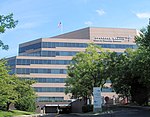
The Space Shuttle program was the fourth human spaceflight program carried out by the U.S. National Aeronautics and Space Administration (NASA), which accomplished routine transportation for Earth-to-orbit crew and cargo from 1981 to 2011. Its official name, Space Transportation System (STS), was taken from a 1969 plan for a system of reusable spacecraft of which it was the only item funded for development. It flew 135 missions and carried 355 astronauts from 16 countries, many on multiple trips.

The Constellation program was a crewed spaceflight program developed by NASA, the space agency of the United States, from 2005 to 2009. The major goals of the program were "completion of the International Space Station" and a "return to the Moon no later than 2020" with a crewed flight to the planet Mars as the ultimate goal. The program's logo reflected the three stages of the program: the Earth (ISS), the Moon, and finally Mars—while the Mars goal also found expression in the name given to the program's booster rockets: Ares. The technological aims of the program included the regaining of significant astronaut experience beyond low Earth orbit and the development of technologies necessary to enable sustained human presence on other planetary bodies.

The Exploration Systems Architecture Study (ESAS) is the official title of a large-scale, system level study released by the National Aeronautics and Space Administration (NASA) in November 2005 of his goal of returning astronauts to the Moon and eventually Mars—known as the Vision for Space Exploration. The Constellation Program was cancelled in 2010 by the Obama Administration and replaced with the Space Launch System, later renamed as the Artemis Program in 2017 under the Trump Administration.

The Altair spacecraft, previously known as the Lunar Surface Access Module or LSAM, was the planned lander spacecraft component of NASA's cancelled Constellation program. Astronauts would have used the spacecraft for landings on the Moon, which was intended to begin around 2019. The Altair spacecraft was planned to be used both for lunar sortie and lunar outpost missions.
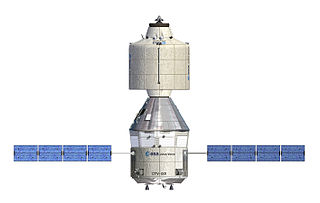
Crew Space Transportation System (CSTS), or Advanced Crew Transportation System (ACTS), was a proposed design for a crewed spacecraft for low Earth orbit operations such as servicing the International Space Station, but also capable of exploration of the Moon and beyond. It was originally a joint project between the European Space Agency (ESA) and the Roscosmos, but later became solely an ESA project. This study was conceived as a basic strategic plan to keep a viable European human spaceflight program alive.

The National Aeronautics and Space Administration is an independent agency of the U.S. federal government responsible for the civil space program, aeronautics research, and space research. Established in 1958, it succeeded the National Advisory Committee for Aeronautics (NACA) to give the U.S. space development effort a distinctly civilian orientation, emphasizing peaceful applications in space science. It has since led most American space exploration, including Project Mercury, Project Gemini, the 1968–1972 Apollo Moon landing missions, the Skylab space station, and the Space Shuttle. It currently supports the International Space Station and oversees the development of the Orion spacecraft and the Space Launch System for the crewed lunar Artemis program, the Commercial Crew spacecraft, and the planned Lunar Gateway space station.

The retirement of NASA's Space Shuttle fleet took place from March to July 2011. Discovery was the first of the three active Space Shuttles to be retired, completing its final mission on March 9, 2011; Endeavour did so on June 1. The final shuttle mission was completed with the landing of Atlantis on July 21, 2011, closing the 30-year Space Shuttle program.

t/Space was an American aerospace company which participated in NASA's Commercial Orbital Transportation Services (COTS), and later, Commercial Crew Development (CCDev) programs for delivering cargo and crew to the International Space Station. The company was headquartered in Reston, Virginia.
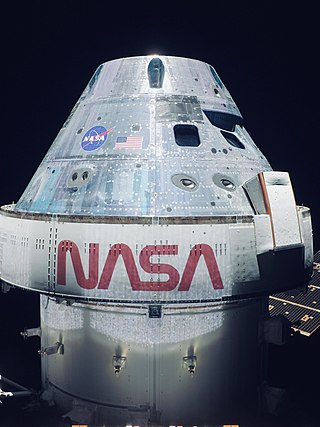
Orion is a partially reusable crewed spacecraft used in NASA's Artemis program. The spacecraft consists of a Crew Module (CM) space capsule designed by Lockheed Martin and the European Service Module (ESM) manufactured by Airbus Defence and Space. Capable of supporting a crew of four beyond low Earth orbit, Orion can last up to 21 days undocked and up to six months docked. It is equipped with solar panels, an automated docking system, and glass cockpit interfaces modeled after those used in the Boeing 787 Dreamliner. A single AJ10 engine provides the spacecraft's primary propulsion, while eight R-4D-11 engines, and six pods of custom reaction control system engines developed by Airbus, provide the spacecraft's secondary propulsion. Orion is intended to launch atop a Space Launch System (SLS) rocket, with a tower launch escape system.

The European Service Module (ESM) is the service module component of the Orion spacecraft, serving as its primary power and propulsion component until it is discarded at the end of each mission. In January 2013, NASA announced that the European Space Agency (ESA) will contribute the service module for Artemis 1, based on the ESA's Automated Transfer Vehicle (ATV). It was delivered by Airbus Defence and Space in Bremen, in northern Germany to NASA at the end of 2018. After approval of the first module, the ESA will provide the ESMs from Artemis 2 to Artemis 6.
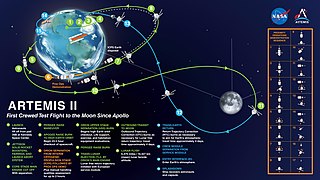
Artemis 2 is a scheduled mission of the NASA-led Artemis program. It will use the second launch of the Space Launch System (SLS) and include the first crewed mission of the Orion spacecraft. The mission is scheduled for no earlier than September 2025. Four astronauts will perform a flyby of the Moon and return to Earth, becoming the first crew to travel beyond low Earth orbit since Apollo 17 in 1972. Artemis 2 will be the first crewed launch from Launch Complex 39B of the Kennedy Space Center since STS-116 in 2006.
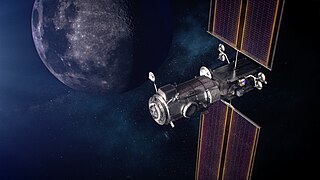
The Lunar Gateway, or simply Gateway, is a space station which Artemis program participants plan to assemble in an orbit near the Moon. The Gateway is intended to serve as a communication hub, science laboratory, and habitation module for astronauts. It is a multinational collaborative project: participants include NASA, the European Space Agency (ESA), the Japan Aerospace Exploration Agency (JAXA), the Canadian Space Agency (CSA) and the Mohammed Bin Rashid Space Centre (MBRSC). The Gateway is planned to be the first space station beyond low Earth orbit.

Blue Moon is a family of lunar landers and their associated infrastructure, intended to carry humans and cargo to the Moon, currently under development by a consortium led by Blue Origin and including Lockheed Martin, Draper, Boeing, Astrobotic, and Honeybee Robotics. Two versions of Blue Moon are under development: a robotic lander planned to land on the Moon in 2024, and a larger human lander planned to land a crew of four astronauts on the lunar surface for the NASA Artemis V mission in 2029.
The Lockheed Martin Lunar Lander is a series of design concepts by Lockheed Martin for a crewed lunar lander.

The Artemis program is a Moon exploration program that is led by the United States' NASA and was formally established in 2017 via Space Policy Directive 1. The Artemis program is intended to reestablish a human presence on the Moon for the first time since Apollo 17 in 1972. The program's stated long-term goal is to establish a permanent base on the Moon to facilitate human missions to Mars.
The Integrated Lander Vehicle (ILV) was a human spaceflight lunar lander design concept proposed in 2020/21 for the NASA Human Landing System (HLS) component of the Artemis program. Blue Origin was the lead contractor for the multi-element lunar lander that was to include major components from several large US government space contractors including Lockheed Martin, Northrop Grumman, and Draper Laboratory.

The Power and Propulsion Element (PPE), previously known as the Asteroid Redirect Vehicle propulsion system, is a planned solar electric ion propulsion module being developed by Maxar Technologies for NASA. It is one of the major components of the Lunar Gateway. The PPE will allow access to the entire lunar surface and a wide range of lunar orbits and double as a space tug for visiting craft.
A Human Landing System (HLS) is a spacecraft in NASA's Artemis program that is expected to land humans on the Moon. These are being designed to convey astronauts from the Lunar Gateway space station in lunar orbit to the lunar surface, sustain them there, and then return them to the Gateway station. As of 2024 NASA intends to use Starship HLS for Artemis III, an enhanced Starship HLS for Artemis IV, and a Blue Origin HLS for Artemis V.























